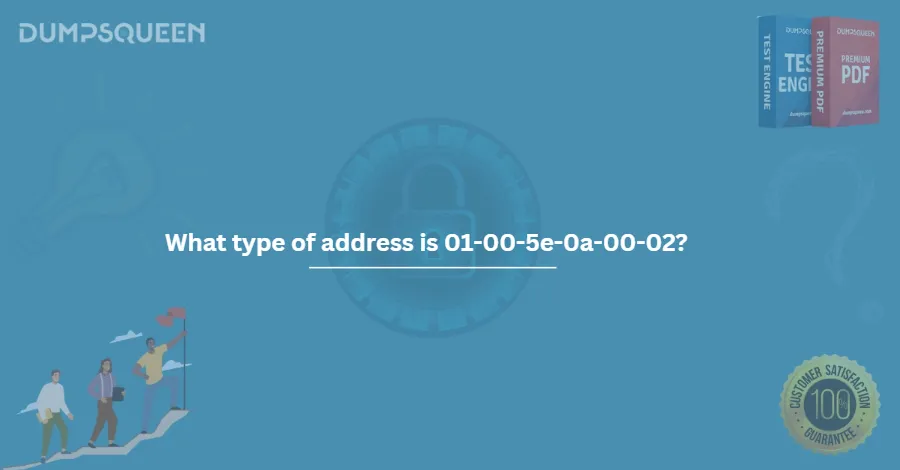Mastering Networking Concepts with DumpsQueen: A Deep Dive into the N10-008 CompTIA Exam
Networking is the backbone of modern technology, and for IT professionals aiming to solidify their expertise, the N10-008 CompTIA Network+ certification is a golden ticket. Whether you're troubleshooting connectivity issues or designing robust network infrastructures, this certification validates your skills. However, mastering the exam requires more than just theoretical knowledge—it demands practical understanding and reliable resources. That’s where DumpsQueen comes in, offering top-tier study materials to help candidates excel. In this blog, we’ll explore the N10-008 exam, dive into the nitty-gritty of MAC addresses (specifically decoding 01-00-5e-0a-00-02), connect it to IPv4 multicast, and highlight why DumpsQueen is your ultimate companion for success.
Overview of the N10-008 CompTIA Exam
The N10-008 CompTIA Network+ exam is a globally recognized certification designed for IT professionals looking to prove their proficiency in networking fundamentals. Launched as an update to its predecessor (N10-007), the N10-008 reflects the evolving demands of the IT landscape, emphasizing modern technologies like cloud computing, virtualization, and advanced security protocols. The exam covers five key domains:
Networking Fundamentals – Understanding core concepts like the OSI model, IP addressing, and network topologies.
Network Implementations – Configuring routers, switches, and wireless networks.
Network Operations – Monitoring and optimizing network performance.
Network Security – Implementing security measures to protect infrastructure.
Network Troubleshooting – Diagnosing and resolving connectivity issues.
With a 90-minute time limit and a mix of multiple-choice and performance-based questions, the N10-008 isn’t a walk in the park. It requires a deep understanding of both theory and real-world application—something DumpsQueen excels at delivering. Their comprehensive study guides and practice questions break down complex topics into digestible chunks, ensuring candidates are well-prepared to tackle every domain. From beginners to seasoned pros, DumpsQueen tailors its resources to meet learners where they are, making it a standout choice for N10-008 prep.
Understanding MAC Addresses
At the heart of networking lies the Media Access Control (MAC) address—a unique identifier assigned to every network interface controller (NIC). Think of it as a digital fingerprint for devices like computers, routers, and switches operating at the Data Link Layer (Layer 2) of the OSI model. A MAC address is a 48-bit hexadecimal number, typically written as six pairs of digits separated by hyphens or colons (e.g., 00-14-22-01-23-45).
MAC addresses serve a critical purpose: they enable devices to communicate within a local network. When a packet is sent across a network, the MAC address ensures it reaches the correct destination on the same subnet. This is distinct from IP addresses, which operate at Layer 3 and handle routing across different networks.
The structure of a MAC address is split into two parts:
Organizationally Unique Identifier (OUI): The first 24 bits, assigned by the IEEE to the manufacturer of the NIC.
Device-Specific Portion: The remaining 24 bits, uniquely assigned by the manufacturer to each device.
For example, a MAC address starting with “00-14-22” might indicate a device made by Dell, while “00-50-56” could point to VMware. Understanding this structure is vital for the N10-008 exam, as it ties into troubleshooting, device identification, and even multicast traffic—topics DumpsQueen covers with precision in its practice materials. With DumpsQueen, you’re not just memorizing facts—you’re learning how to apply them in real-world scenarios.
Decoding the Address: 01-00-5e-0a-00-02
Let’s take a closer look at the MAC address 01-00-5e-0a-00-02, which offers a fascinating glimpse into networking’s inner workings. At first glance, it might seem like a random string, but every segment tells a story.
01-00-5e: This prefix is a dead giveaway. The sequence “01-00-5e” is reserved for multicast MAC addresses, specifically those mapped to IPv4 multicast traffic. Unlike unicast addresses (which target a single device) or broadcast addresses (which target all devices), multicast addresses deliver data to a specific group of devices that have subscribed to receive it. The IEEE designates the range 01-00-5e-00-00-00 to 01-00-5e-7f-ff-ff for this purpose.
0a-00-02: The second half of the address corresponds to the specific multicast group. In this case, it’s tied to an IPv4 multicast address, which we’ll decode further in the next section.
Why does this matter for the N10-008 exam? Because multicast traffic is a key concept in modern networking, especially for applications like video streaming, online gaming, and IP telephony. Understanding how a MAC address like 01-00-5e-0a-00-02 functions helps you grasp how data flows efficiently across networks without overwhelming every device. DumpsQueen’s study resources shine here, offering detailed explanations and practice questions that connect abstract concepts like MAC addressing to practical exam scenarios. Their materials don’t just tell you what a multicast address is—they show you how to recognize and work with one.
Practical Application in Networking
So, how does a MAC address like 01-00-5e-0a-00-02 play out in the real world? Imagine you’re a network administrator managing a corporate network. Your company uses a video conferencing tool that relies on multicast to stream meetings to multiple employees simultaneously. Without multicast, the server would have to send individual streams to each participant, clogging the network with redundant traffic. Instead, the tool leverages a multicast group, and the MAC address 01-00-5e-0a-00-02 ensures that only subscribed devices (like employee laptops) receive the stream.
Switches in the network use IGMP snooping (Internet Group Management Protocol) to listen for multicast traffic and forward it only to ports where devices have joined the group. This optimizes bandwidth and reduces latency—skills you’ll need to demonstrate on the N10-008 exam. Troubleshooting such a setup might involve verifying that the switch is correctly mapping the multicast MAC address to the right ports, or ensuring that a firewall isn’t blocking the traffic.
DumpsQueen prepares you for these hands-on challenges. Their performance-based practice questions simulate real-world tasks—like configuring a switch for multicast or diagnosing a connectivity issue tied to a MAC address. By working through these scenarios, you’ll gain the confidence to handle anything the N10-008 throws your way.
Connection to IPv4 Multicast
The MAC address 01-00-5e-0a-00-02 doesn’t exist in isolation—it’s intricately linked to IPv4 multicast. Multicast IP addresses range from 224.0.0.0 to 239.255.255.255, and they map to MAC addresses in the 01-00-5e range. Here’s how it works:
- The first 24 bits of the multicast MAC address are fixed as 01-00-5e.
- The next bit is always 0 (to stay within the designated range).
- The final 23 bits are derived from the last 23 bits of the IPv4 multicast address.
Let’s decode 01-00-5e-0a-00-02:
- Convert the last three octets (0a-00-02) to binary: 00001010-00000000-00000010.
- This gives us the 23 bits: 00001010 00000000 00000010.
- Map it to an IPv4 address: The multicast range starts at 224.0.0.0, and the last 23 bits correspond to 10.0.2.
- Result: 234.10.0.2 (since 224 + 10 = 234).
Thus, the MAC address 01-00-5e-0a-00-02 corresponds to the IPv4 multicast address 234.10.0.2. This mapping isn’t one-to-one—32 different IPv4 multicast addresses can map to the same MAC address due to the 23-bit overlap—but it’s efficient for most practical purposes.
For the N10-008 exam, understanding this relationship is crucial. You might encounter a question asking you to identify a multicast address or troubleshoot a misconfigured multicast group. DumpsQueen’s detailed breakdowns of IP-to-MAC mapping make this complex topic accessible, ensuring you’re ready to ace related questions.
Relevance to N10-008 - CompTIA Network+
The N10-008 exam tests your ability to navigate both foundational and advanced networking concepts, and everything we’ve discussed—MAC addresses, multicast, and IPv4—ties directly into the curriculum. In the Networking Fundamentals domain, you’ll need to explain how MAC addresses function at Layer 2. In Network Implementations, configuring multicast traffic might come up. And in Network Troubleshooting, diagnosing issues with multicast delivery could be a performance-based task.
DumpsQueen aligns perfectly with these objectives. Their study materials are updated to reflect the N10-008’s focus on modern networking, offering practice questions that mirror the exam’s format and difficulty. Whether you’re decoding a MAC address or setting up a multicast group, DumpsQueen provides the tools to master the skills employers and CompTIA expect.
Conclusion
The N10-008 CompTIA Network+ exam is a challenging but rewarding step for any IT professional. From understanding the nuances of MAC addresses like 01-00-5e-0a-00-02 to applying multicast concepts in real-world scenarios, success hinges on preparation. That’s where DumpsQueen stands out. With its expertly crafted resources, practical examples, and exam-focused content, DumpsQueen transforms daunting topics into manageable lessons. Whether you’re a newbie or a veteran, their materials guide you toward certification with clarity and confidence. So, if you’re aiming to conquer the N10-008, trust DumpsQueen to be your partner in success—because in the world of networking, knowledge is power, and DumpsQueen delivers it in spades.
Free Sample Questions
What type of address is 01-00-5e-0a-00-02?
A) MAC Address
B) IPv4 Address
C) Multicast MAC Address
D) Broadcast MAC Address
Answer: C) Multicast MAC Address
The address 01-00-5e-0a-00-02 represents which type of network address?
A) Unicast MAC Address
B) Multicast MAC Address
C) IPv6 Address
D) Broadcast Address
Answer: B) Multicast MAC Address
Which type of MAC address does 01-00-5e-0a-00-02 belong to?
A) Broadcast Address
B) Group Address
C) Multicast Address
D) Unicast Address
Answer: C) Multicast Address
The address 01-00-5e-0a-00-02 is typically used for what kind of communication in networks?
A) Unicast communication
B) Multicast communication
C) Broadcast communication
D) Point-to-point communication
Answer: B) Multicast communication
The address 01-00-5e-0a-00-02 is associated with which of the following protocols?
A) TCP
B) UDP
C) IPv6
D) Multicast Ethernet
Answer: D) Multicast Ethernet




